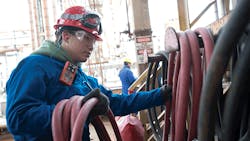The Role of Real-Time Detection in Industrial Hygiene
I'm not an industrial hygienist and I don't claim to be one. However, I've spent nearly 30 years in the business of gas detection and have worked closely with the industrial hygiene community for most of that time.
Among other responsibilities, industrial hygienists identify, measure and evaluate workplace exposures and hazards, and implement programs and processes to control them. Real-time detection systems are direct-reading systems that produce immediate results and feedback. While there tends to be a greater focus on gas and vapor detection when real-time systems are considered, the role of real-time systems for measuring noise, particulate matter and other real-time hazards should not be overlooked. But as my experience dictates, we'll focus on the importance of real-time gas and vapor detection.
When we think of "gas" detection, we tend to look toward hazards such as hydrogen sulfide, carbon monoxide, explosive gas or oxygen deficiency – hazards that we know can snuff out life in an instant. Real-time methods and equipment to detect these hazards probably are taken too much for granted. They are relatively easy for industrial hygienists and other safety professionals to understand and use. But the hazards go much deeper than just simple gases. The ability to detect them quickly – in real time – and interpret the results to ensure worker health and safety is of vital importance.
Real-World Applications
I recently participated in a safety meeting that focused on the exposure of oilfield workers to volatile organic compounds such as benzene and naphthalene. There certainly are tools available to detect these hazards in real-time, but using them and interpreting the results from them definitely is not as straightforward as using a simple hydrogen sulfide detector. These tools may work adequately for making hazard assessments, but they typically are more complicated for everyday workers to use and understand than an industrial hygienist would like. The nature of these tools often makes it difficult for industrial hygienists to implement them as a control in a sustainable process that has to protect workers in real-time on an everyday basis.
When real-time systems are not available, industrial hygienists must turn to more "old-school" methods of detection. Charcoal collection filters, grab-bag samples and passive exposure badges can be used to evaluate hazards, but they require time and effort to collect samples that must be sent to a qualified laboratory that is capable of analyzing them and providing the results.
The time these tests take certainly is real, but the feedback isn't anywhere near immediate and the economics of these methods are questionable. In a one-off situation, having a grab-bag sample or charcoal filter analyzed is fairly inexpensive, but to do it on a large scale, across a large facility and on a more daily basis requires time and money that a diminishing industrial hygiene workforce and reduced budget typically cannot tolerate.
Industrial hygienists rely on accurate data – often lots of it – when making hazard assessments, looking for answers to problems and developing controls. Real-time systems can provide the amount of data needed in almost every case. Accuracy of real-time detection increases with the analytical nature of the tool. If you spend more money on the equipment, you should expect better accuracy from the results.
Analytical Detection Methods
The best accuracy most likely comes from those non-real-time, analytical detection methods. Real-time detection tools (such as portable instruments) probably provide enough accuracy for almost every situation in which day-to-day protection of workers is the primary concern and the action levels defined provide a large margin of safety. But when the industrial hygiene need calls for true analytical accuracy of the results, real-time systems probably are not the answer and the burden on the industrial hygienist to get the job done is greater.
When talking about real-time detection systems, actually how real-time is "real-time?" From an industrial hygiene perspective, the answer is "not very." The detection of the hazard and the production of the result is in real time, but the delivery of the information certainly is not. Unless the industrial hygienist is carrying the detector into the field himself or standing next to the worker wearing or actually using the device, he has to wait to get the information from it. While that wait is not as long as he would experience when sending test samples to a lab for analysis, he will, nevertheless, have to wait for results. The instrument must be brought in from the field to have the data extracted from it for analysis.
There is plenty of information to analyze, but it is going to be done after the fact and very rarely in "real time." Manufacturers are putting greater emphasis on collecting real-time data through wireless systems, but design of highly reliable systems that work with complex physical environments and adoption of existing systems is slow. Without them, however, we won't get to the place where the industrial hygiene community truly can have real-time detection and analysis.
Support for Real-Time Detection
Organizations within industry clearly are focused on supporting and promoting real-time detection systems. The American Industrial Hygiene Association has a Real Time Detection Systems Committee, which is a conglomeration of representatives from equipment manufacturers and industry stakeholders within the industrial hygiene, occupational health and regulatory community. This committee is dedicated to providing leadership in the field of gas and vapor detection and maintaining knowledge of tools and methods related to industrial hygiene. Members actively share their expertise to drive improved technologies and to provide workers with the best possible real-time protection.
Real-time problems require real-time solutions. If we continue to work together as a community within the industry, we will achieve an end to real-time death on the job.
Dave Wagner is the global director of product knowledge & iNet product manager for Oakdale, Pa.-based Industrial Scientific Corp. He can be reached at [email protected].
